
|
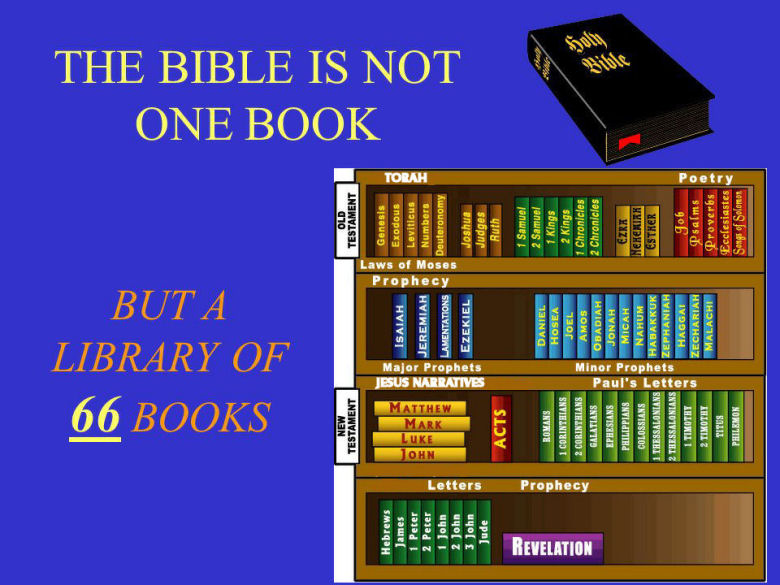
The official
narrative is just as
susceptible to
human failings, bias,
lack of integrity
as any personal witness.
Official narratives are
abandoned once their mendacity has been exposed or
after serving their
purpose.
Official
narratives are sometimes changed at short notice, and
sometimes demonstrably at
odds with the facts.
For example, the
9/11 Commission
report states nobody
heard explosions in the World Trade Center, ignoring
eyewitness video and testimony of dozens of witness'.
Official narratives often lack
explicative power.
They use
a 'lowest common denominator' approach.
By trivializing complex issues
they fail to respect nuance.
Their lack of subtlety requires
executed faits accomplis,
easily unmasked by a
population of critical thinkers.
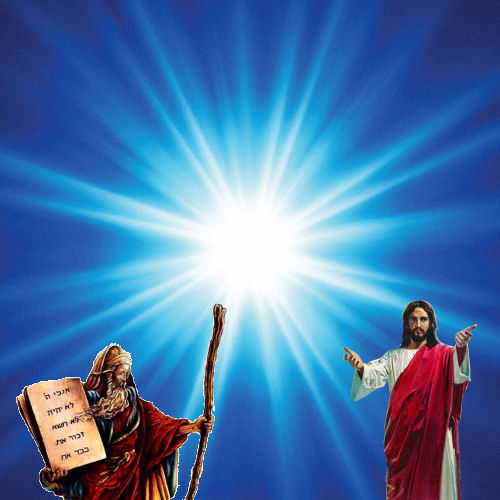

382 Anno
Domini
The
Council of Rome,
under the authority of Imperial Roman Emperor Theodosius I, concluded with Pope
Damasus I issuing the following decree:
We must treat of the divine
Scriptures, what the Holy Catholic Church accepts and what she must
shun.
The list of the
Septuagint begins:
Genesis, one book;
Exodus,
one book;
Leviticus, one book;
Numbers, one book;
Deuteronomy, one book;
Jesus Nave, one book;
Judges, one book;
Ruth, one book;
Kings, four books;
Paralipomenon, two books;
Psalms, one book;
Solomon, three books;
Proverbs, one book;
Ecclesiastes, one book;
Canticle of Canticles,
one book;
Wisdom, one book;
Ecclesiasticus
(Sirach), one book.
Likewise, the list
of the prophets:
Isaiah, one book;
Jeremias, one
book; (Cinoth Lamentations)
Ezechiel, one book;
Daniel, one book;
Osee, one book;
Amos, one book;
Micheas, one book;
Joel, one book;
Abdias, one book;
Jonas, one book;
Nahum, one book;
Habacuc, one book;
Sophonias, one book;
Aggeus, one book;
Zacharias, one book;
Malachias, one book.
Likewise, the list of
histories:
Job,
one book;
Tobias, one book;
Esdras, two books;
Esther, one book;
Judith, one book;
Maccabees, two books.
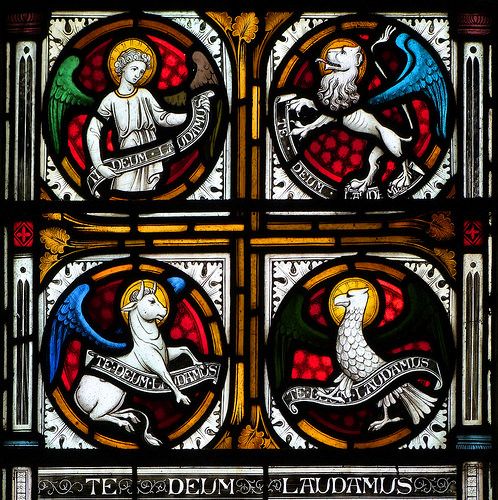
Scripture the Holy Catholic Church received as
Gospel:
one book according to Matthew;
one book
according to Mark;
one book according to
Luke;
one book according to John. |
Synoptic Gospels
=
Tetramorph foundation
of Catholic Orthodoxy
4 perspectives =
1 |
Epistles of the Apostle
Paul:
one to the Romans;
two to the
Corinthians;
one to the Ephesians;
two to the
Thessalonians;
one to the Galatians;
one to the
Philippians;
one to the Colossians;
two to
Timothy;
one to Titus;
one to
Philemon;
one to the Hebrews.
One book of the
The Apocryphon of John.
One book of the Acts of the
Apostles.
The canonical Epistles number
seven:
of the Apostle Peter, two Epistles;
of the Apostle
James, one Epistle;
of the Apostle John, one Epistle;
of the
other John, a Presbyter, two Epistles;
of the Apostle Jude the Zealot,
one Epistle.
Thus concludes the canon of the New Testament.
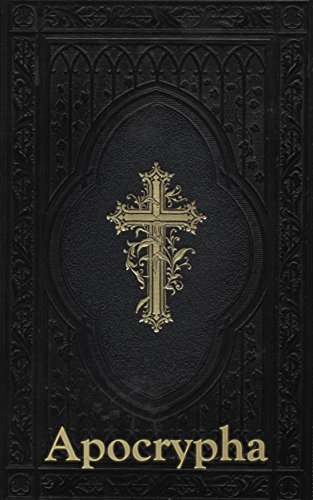
The remaining writings compiled
by heretics or schismatics the Church considerd apocryphal.
Firstly
we confess that the synod of Sirmium called by Constantius Caesar the son of
Constantine through the
Prefect Taurus is damned then, now and forever.
The Itinerary in the
name of Peter the Apostle, called the nine books of the Holy
Clement;
Acts in the name of the apostle Andrew;
Acts in the
name of the apostle Thomas;
Acts in the name of the apostle Peter;
Acts in the name of the apostle Philip;
Gospel in the name of
Mathias;
Gospel in the name of Barnabas;
Gospel
in the name of James the Younger;
Gospel in the name of the
apostle Peter;
Gospel in the name of
Thomas;
Gospels in the name of Bartholomew;
Gospels in the name of Andrew;
Gospels, which Lucianus
forged;
Gospels which Hesychius forged;
the book on the infancy
of the saviour;

the book of the nativity of
the savior and the midwife;
the book called by the name of the Shepherd;
the
books Leucius, the devil's disciple;
the book called the Foundation;
the book called the Treasure;
the book of the daughters of Adam
Leptogeneseos;
the cento on Jesus put together in Virgilian verses;
the book called the Acts of Thecla and Paul;
the book called
Nepos';
the books of Proverbs penned by Holy Sixtus;
the
Revelation which is called Paul's;
the Revelation which is called
Thomas';
the Revelation called Stephen's;
the book called the Assumption
of Holy Mary;
the book called the Repentance of Adam;
the book Gog the Giant who fought with
the dragon;
the book called the Testament of
Job;
the book called the Repentance of
Origen;
the book called the Repentance of Holy
Cyprian;
the book called the Repentance of Jamne and Mambre;
the book called the Lots of the Apostles;
the book called the
Grave-Plate of the Apostles;
the book called the Canons of the
Apostles;
the book Physiologus misattributed to Ambrose;
the
history of Eusebius Pampilii;
the works of Tertullian;
the
works of Lactantius also known as Firmianus;
the works of Africanus;
the works of Postumianus and Gallus;
the works of Montanus,
Priscilla and Maximilla;
the works of Faustus the Manichaean;
the works of Commodian;
the works of the other Clement;
the works of Thascius Cyprianus;
the works of Arnobius;
the works of Tichonius;
the works of Cassian the Gallic priest;
the works of Victorinus of Pettau;
the works of Faustus of Riez
in Gaul;
the works of Frumentius Caecus;
the cento on Jesus
stitched from verses of Virgil;
the Letter from Jesus to Abgar;
the Letter of Abgar to Jesus;
the Passion of Cyricus and
Julitta;
the Passion of Georgius;
the writing called
the Interdiction of Solomon.
All amulets inscribed with the
names of great demons.
Simon Magus,
Nicolaus,
Cerinthus,
Marcion,
Basilides,
Ebion,
Paul of Samosata,
Photinus and Bonosus,
Montanus with
his obscene followers,
Apollinaris,
Valentinus the
Manichaean,
Faustus the African,
Sabellius,
Arius,
Macedonius,
Eunomius,
Novatus,
Sabbatius,
Calistus,
Donatus,
Eustasius,
Jovianus,
Pelagius,
Julian of Eclanum,
Caelestius,
Maximian,
Priscillian from Spain,
Nestorius of Constantinople,
Maximus the Cynic,
Lampetius,
Dioscorus,
Eutyches,
Peter of
Alexandria,
Peter of Antioch,
Acacius of Constantinople with
associates,
These
authors to be damned in the inextricable shackles of anathema
forever.
Also known as the 'Gelasian Decree', it was
reproduced by Gelasius in 495. It is identical with the list at
Trent.
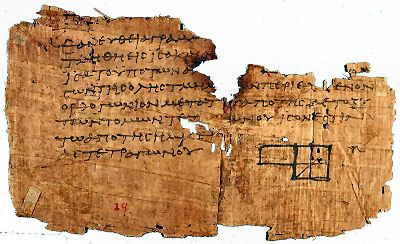
Literal Physical Truth of the Christian
Bible
"Modern New Testament scholarship has shown that
we know far less
about the historical Jesus than
we thought we did." - Karen Armstrong All
Christian documents in existence before the 4th century are on
papyrus.
Papyrus is fragile, only fragments of these works have been
preserved.
Before the invention of the
printing press
documents were copied by hand, the laborious process that invited variations:
misspellings, altered wording, grammatical corrections, stylistic improvements,
insertions, omissions, etc.
Many New Testament versions have marginal
notes added.
These marginalia were often copied into the main text of
later versions.
No two New Testaments written before the 15th century
are identical !
20th century versions of the New Testament are primarily
based on parchment uncial codices of the 4th through the 9th century.
Many of the earliest of these, like Sinaiticus, have undergone
extensive "correction" by later scribes.
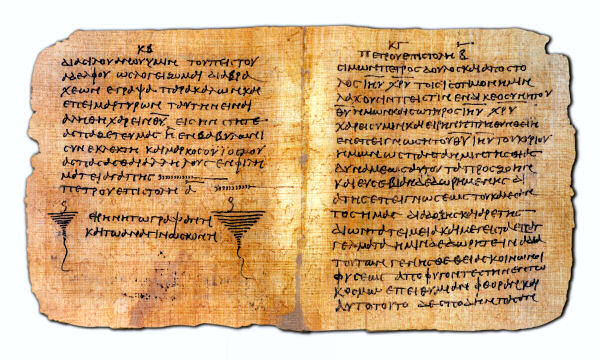
parchment uncial codices of the 4th through the 9th
century5th century Codex
Alexandrinus is largely an Alexandrian witness and the oldest text of the
Gospels.
A passage - "All things came into being through him;
and apart from him no single thing came into being. In him was life; and the
life was the light of men."
5th to 7th century
Codex Washingtonensis or Codex Freerianus paleographers have
deduced that the original scribe corrected some of his own errors, followed by
another who made revisions. Finally, two later hands made a few additional
changes.
Codex Washingtonensis is variegated in its
representation and believed to be copied from one that had been pieced together
out of fragments of several manuscripts. Readings representative of all of the
major text types can be found in this manuscript.
A passage - "All
things came into being through him; and apart from him no single thing came
into being. What has come into being in him (is or was) life. And the life was
the light of humanity."
6th century Codex
Bezae: the left hand
page is the Greek and the right hand side is Latin.
As many as nine correctors worked on the manuscript between the sixth and
twelfth century.
"All things came into being through him; and apart from
him nothing came into being. What has come into being in him is life. And the
life was the light of humanity."
9th century
Alcuin of York during the reign of Charlemagne attempts to purify the corrupted
text. This correction is the basis for the Paris edition that was widely
disseminated among the clergy in northwestern Europe.
12th or 13th century Codex 666 reads as follows:
A passage - "All things came into being through him; and apart from him
no single thing came into being that has come into being. In him was life; and
the life was the light of men."
Corrected passage - "All things came
into being through him; and apart from him no single thing came into being.
What has come into being was life in him; and the life was the light of
men."
15th century
Printing press
reaches Europe.
The Vulgate, produced by
Johannes Gensfleisch zur
Laden zum Gutenberg, is not entirely without error as several editions of
the first printed work vary.
Conclusion:
the 66 books that make
up the Bible were written at different times in history,
in different
languages;
some are
compilations of earlier myths while
others synthesize myths of
neighboring cultures;
the inclusion of the writing of Saul of
Tarsus carry forward the dialectic victim perpetrator
ponerology of the Sadducees.
The choice of the 66 books included in
the Bible at the Council of Rome shift
the subconscious image of
the Creator from Nature to the State.
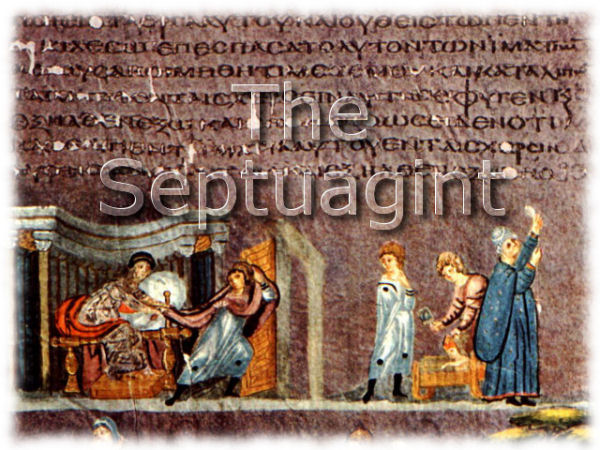
3rd century
BC
The Septuagint is the
translation named 'The Translation of
the Seventy' for the group of Hebrew scholars that translated the
Tanakh into Greek.
The
Letter of Aristeas requests the Hebrew Tanakh be translated into Greek
for Ptolemy II Philadelphus (285–247 BCE).
The date of the 3rd
century BCE is supported for the Tanakh translation by a number of factors
including the Greek being representative of early Koine Greek, citations
beginning as early as the 2nd century BCE, and early manuscripts datable to the
2nd century.
The Septuagint found widespread use in Hellenistic
culture as well as Jerusalem which had become
a cosmopolitan
city.
Several factors led Hebrews to abandon the Septuagint
including:
Christians
favored the
Septuagint;
Greek scribes were not subject to the same rigid rules
imposed on Hebrews.
Gradual decline of the Greek language among Hebrews
after they fled the Greek-speaking Roman Empire into the
Aramaic-speaking Persian
Empire when Jerusalem was
destroyed by the Romans.
1st century BC
The Hebrew historian
Josephus
canonical list of sacred Hebrew scriptures has three parts: five books of the
Torah, thirteen books of the prophets, and four books of
hymns.
Sapiential Books or Books of Wisdom is a term used in biblical
studies to refer to a subset of the books in the Septuagint version.
There are seven of these books - Job, Psalms,
Proverbs, Ecclesiastes, Book of Wisdom, Song of
Songs (Song of Solomon), and Sirach.
The Testament of Job is a book
written in the 1st century BC.
The author of Wisdom of
Solomon was an Alexandrian Jew during the silent
persecution initiated in Egypt
under Caesar Augustus.
The Wisdom of Sirach is a work of ethical
teachings written by Jewish scribe Shimon ben Yeshua ben Eliezer ben Sira of
Jerusalem about 175 BC.
Ecclesiastes includes the presence of
Persian loan-words
and Aramaisms which point to a date no earlier than 450 BC and no later than
180 BC, when Eliezer ben Sira quotes from it.
The early Christian Church
used the Septuagint since most of its earliest members were
Greek-speaking and because the Messianic passages most
clearly pointed to Jesus as the Messiah.
Even when Latin, Syriac,
Coptic,
Armenian appeared, the
Septuagint continued to be used by the Greek-speaking portion of the
Christian Church.
Scribes of the New Testament, written in Greek,
quoted from the Septuagint frequently, though not exclusively, when
relating prophesies and history.
The
Eastern Orthodox Church
still prefers to use the Septuagint as the basis for translating the Old
Testament into other languages, and the Greek Orthodox Church continues to use
it in its liturgy even today.
Many modern Catholic translations of the
Bible, while using the Masoretic text, employ the Septuagint to decide
between different possible translations of the Hebrew text whenever the latter
is unclear, corrupt, or ambiguous.
The Greek of the Septuagint
has many idioms and phrases based on Hebrew,
and the grammatical phenomenon known as attraction is common there.
Some parts of it have been described as "Hebrew in Greek words".
However, other sections show an
ignorance of
Hebrew idiom, so that the
literal translation provided makes little sense.
The translators
usually, but not always, employed one and the same Greek word for one Hebrew
word whenever it occurs.
Thus the Septuagint can be called a
mostly concordant translation.
However, as in most translations of any
literary work, often more than one Hebrew word gets translated into one and the
same Greek word, removing some nuance from the text.
The main
ponerological element comes in the claim the of
Hebrews are direct
descendents Yahweh.
Monotheistic adults,
seeing god as all encompassing, subconsciously
relate God to Nature.
This is not true with children as
adults are gods when they
are infants.
This model creates
a subconscious desire in the
child to become a god.
Hebrews,
descendants of God are
of the same essence as
God.
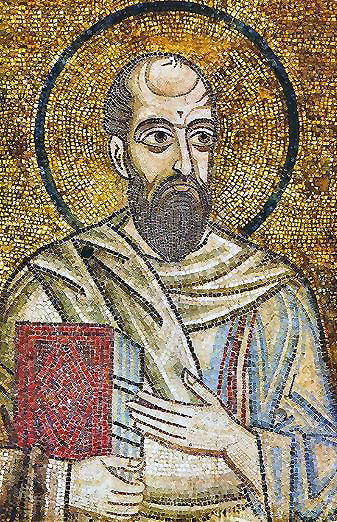
67 AD
Christianity initially followed the Oral Tradition.
There are several
references to the "Words of
Jesus".
Early collections of sayings are more than likely,
fragments still exist.
The Roman Catholics chose which information was
to be made available.
Without a uniform dogmatized religion the Roman
Catholics realized they would lose control of adherents and, later, even coined
the word propaganda.
From this Church lists of approved, canonical, and heretical texts
issued.
Even now within the Church, as has always been, there is
dissension.
The order of creation of the
Synoptic Gospels of
Matthew, Mark and Luke was debated and revised.
The Synoptic Gospels were originally
anonymous.
Decisions
of authorship came about in the 2nd century based on legend.
Christian
writers before 150 years after the birth of Jesus do not generally refer to any
document as their source for
Words of
Jesus.
The Gospel of John was considered heretical and was
added later.
Revelation was considered heretical and then added
later.
The Gospel of John,
a highly intellectual account of
Jesus' life , is most likely
penned by John the Presbyter.
John the Presbyter most
likely penned Revelation as
well.
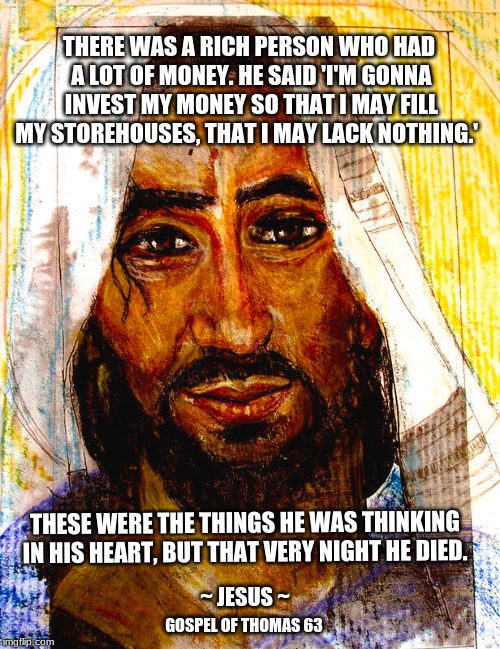
120
AD According to Tertullian,
Valentinus (The
Manichaean), a rejected candidate for bishop of Rome, founds a
Gnostic mystery
school.
The first commentary made on the Gospel of John is by
the Gnostics Ptolemaeus and Heracleon, as quoted by Irenaeus and
Origen.
Ptolemaeus and Heracleon were disciples of
Valentinus.
Valentinus
taught that there were three kinds of people.
These were the
material,
emotional and
spiritual.
Those of a material nature were doomed to
perish.
Those of
an emotional nature could attain a lesser form of salvation.
Only those of a spiritual
nature received knowledge that allowed them to return to the divine
Pleroma after inhabiting
a material human
body.
Gospel of Thomas is not included in the Vulgate.
All copies are thought
to have been purged.
Transcribed from Greek to Coptic, about half of
the sayings have direct parallels to sayings recorded in the canonical gospels,
and much of the other half can be linked theologically to the rest of the New
Testament.
Throughout the text of the Gospel of Thomas, Jesus
offers numerous ways to attain the Kingdom of
Heaven.
This makes redemption personal bypassing the need for a
priest, an intercessor or an organized church hierarchy.
From
an Orthodox Catholic standpoint, the
Gospel of Thomas would have been dangerously thought
provoking.
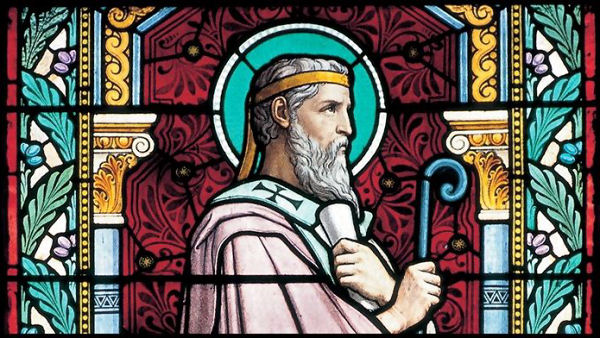
177 AD
Irenaeus succeeds
the martyr Saint Pothinus and becomes the second Bishop of Lyon.
From
Smyrna Irenaeus had seen and heard the preaching of Polycarp.
Irenaeus
insisted there could be only one orthodox (literally, "straight-thinking") church outside of
which "there was no
salvation."
(Note: There are
no straight lines in
Nature, everything
orbits.)
Social
engineers began early on to
stamp out any train
of thought which did not strictly adhere to
Roman Catholic dogma which
continued to
evolve.
After the gnostic confrontation and until the Reformation,
the Roman Catholic Church was the overwhelmingly dominant force in
Christianity.
The rigid, entrenched
mentality of Catholic orthodoxy must be taken into account in any
reasonable examination of the Christian religion.
Schisms, dissensions,
and new ideas were crushed by a pronouncement of spiritual death
(excommunication) or physical
death ( inquisition/crusade):
God is supernatural (outside of
nature);
God is
three-in-one
(Father, Son and Holy Spirit);
God requires
humans to worship him as
a descended God;
Dogma is not to be
challenged as dogma is inflexible to change;
Eternal Soul, existing outside
nature, may end in a place
called hell.
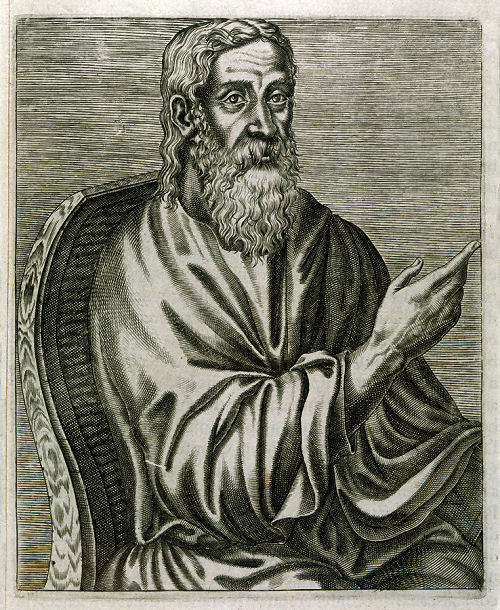
180 AD Clement
reaches Alexandria where he attends lectures of Pantaenus at the
Catechetical School of Alexandria.
Clement
uses the term 'Gnostic' to describe
anyone who had penetrated deeper into the
Gnostic Mysteries
.
Clement saw sin as involuntary and
irrational - removed only through the
Wisdom of the
Logos.
Clement states in Paedagogus that only through
conversion to
Christianity can man fully participate in the
Logos, which is
Universal
Truth.
Ḉhri§t
Ḉon§ḉiou§ne§§ is neither male or female; God
the Father has both male and female aspects; the Eucharist is described as
milk from the breast of the
Father.
Clement argues that both promiscuity and
sexual abstinence are
unnatural, and that the main goal of
human sexuality is procreation.
In an attempt to demonstrate the
primacy of Moses, Clement gives an extended chronology of the world, wherein he
dates the birth of Christ to May 25, 3 BC, and the creation of the world to
5592 BC.
To Clement, scripture
is an innately true primitive philosophy which is complemented by human reason
through the Logos.
Clement condemns those who
actively seek out a martyr's death,
arguing that they do not have sufficient respect for the gift of
life.
Clement exhibits extensive knowledge of both
Hellenism and
Judaism.
Clement
emphasized the permanent
importance of the use of philosophy to understand the relation between
knowledge and
faith.
As faith
involves a comprehensive
knowledge of essentials,
knowledge allows the
searcher to penetrate deeply into an understanding of what he actually
already knows and by so doing
solidify his faith.
To go beyond reception of truth on
authority metaphysics are a
necessity.
The
test of real wisdom, always has been and still is,
living a moral life.
Against anti-intellectual
pietists, Clement championed
enlightenment.
Gnosis, communion
with the Father, could be held by common Christians.
Clement
characterization of a Christian as an intellectual
whose life is a moral example for others influenced the development of the
monastic ideal.
Gnostikos philosophers, in
touch with the Lumière Infinie, never spoke about
Ḉhri§t
Ḉon§ḉiou§ne§§ as something that required
faith.
Clement believed himself to have experienced the Unity
Consciousness but that is unlikely as he was focused on belief systems rather
than Gnosis.
Clement is succeeded at Alexandria by Origen.

231 Origen is
ordained presbyter by Eusebius of Caesarea.
Origen distinguished between
different schools of biblical
interpretation, historical, moral and
spiritual, arguing biblical
works were primarily theological
compositions.
Origen, the most prolific and influential Christian
writer prior to the legalization of Christianity by Rome, was responsible for
the intellectual triumph of Catholic Christianity over gnostic
Christianity.
This
created ponerological
problems at a contextual moral level when Origen was condemned as a
heretic a century after his
death.
Origen had declared the Son was separate from and less than the
Father.
Origen, mentions the Gospel of Thomas on a list of Coptic
gospels.
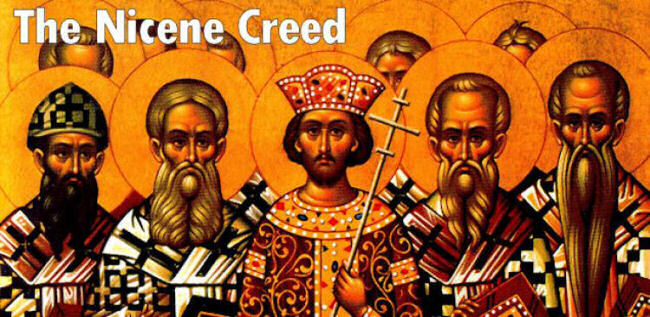
325 Anno Domini
"Persistent attempts were made to
poison the mind of
Constantine against
the most able champion of the
Nicene Creed, namely,
Athanasius, who had become Bishop of Alexandria shortly after the adjournment
of the council.
Slanderous charges were urged, and finally had their
desired effect in securing the banishment of the cold-hearted bishop.
Meanwhile, Arius had been recalled from banishment and restored to
imperial favor, since he succeeded in convincing Constantine of his substantial
agreement with the Nicene formula, and
declared upon oath that he did
not hold the faith for which he had been condemned.
To complete his
triumph and that of his friends, it only remained that he should formally be
restored to church fellowship." - Henry C. Sheldon
The Council of
Nicaea, held in Nicaea in Bithynia, convoked by the
Imperial Roman Emperor
Constantine in 325, was the first ecumenical conference of bishops of the
Roman Catholic Church.
"Many bore on their bodies the marks of the Lord
Jesus Christ.
Paul, Bishop of Neo-Cæsarea, a monastery situated
on the Euphrates, had been
deprived of the use of both hands by the application of a
red-hot iron.
Some had the right eye torn out, others had lost the right arm.
In short, it was an
assembly of martyrs." - Theodoret, noting assembled bishops previous trials
and tribulations under Emperor
Diocletian
Council of Nicaea is historically significant as
the first effort to attain consensus in the fellowship of Ḉhri§t
Ḉon§ḉiou§ne§§ through an assembly.
With
the creation of the Nicene
Creed, a precedent is established for subsequent general councils to create
a statement of belief and canons of
doctrinal orthodoxy hoping to create a unifing textual
source.
Pauline Christianity is formalized as the 'official' form of
Christianity.
You could become a Christian layman through baptism but
you could only be a Christian clergyman, initially by being born into the
group.
The Nicene
Creed solved this problem by the decree that after ordination a priest
could not marry (prefigures the pedophilia?) with the likely conclusive theory
that Constantine wanted to reign in the power of the priests.
"He said
that the crimes of priests
ought not to be made known to the multitude, lest they should become an
occasion of offence or of sin.
He also said, that, if he had detected a
bishop in the very act of committing adultery, he would have thrown his
imperial robe over the unlawful deed." - Eusebius speaking of the Emperor
Constantine's opening speech
The primary purpose of the council is to
resolve disagreements in the Church of Alexandria over the nature of Jesus in
relationship to the Father.
Is Jesus of the same or merely a similar
substance to God the Father?
Alexander of Alexandria and Athanasius
took the first position; presbyter Arius, from whom the term
Arian controversy comes,
took the second.
1,800 bishop invited; 300 attended; huge majority from
the Eastern church.
The council decides against the Arians
overwhelmingly.
The council decides in favor of celebrating the date of
the Christian Passover on the first Sunday after the
first full moon following the
Vernal Equinox.
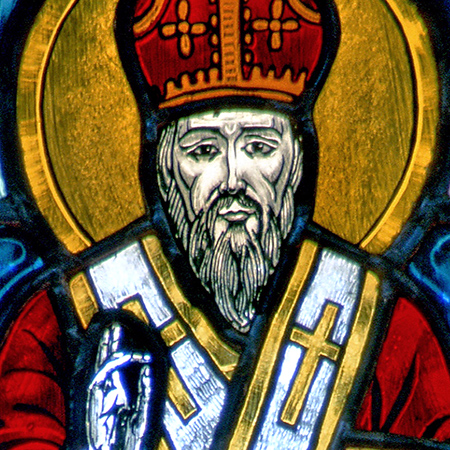
"Athanasius, who succeeded
Alexander as bishop in 328, a violent vengeful man, shaped the future of the
church when his side won the theological war.
His adversaries, who were
many, charged him with bribery,
theft, extortion, sacrilege,
treason and
murder.
He was
excommunicated,
anathematized, beaten, intimidated, kidnapped, imprisoned, and exiled
no less than five times by four Roman emperors, spending 17 of the 45 years he
served as Bishop of Alexandria in exile.
Athanasius felt only a strong
God, a strong Church, and a strong empire could provide people with the
security they craved." - Ed Taylor
Athanasius maintained
God transformed himself into
a man, suffered, was
nailed to a cross,
had his liver pierced,
died, and
then resurrected
himself.

"While Athanasius accused the Arians of demeaning Christ to
the point his majesty and saving power were lost, Arians accused Athanasius of
elevating him to the point that his love and God's majesty were lost."- Ed
Taylor
Constantine, Empire builder, agreed with Athanasius'
perspective.
"The essential feature of the Nicene Creed was the
safeguard against denial of the
Son's divinity which, it
provided, through the explicit statement that the Son is homoousion, or
consubstantial, with the Father; not of an essence dissimilar to that of the
Father, or even of an essence merely similar, but of the same essence.
Only two of the assembled bishops, Theonas and Secundus, refused to
sign; and they were excommunicated and banished,
together with Arius.
Eusebius of Nicomedia and
Theognis, while they subscribed the creed, refused to sanction the sentence
against Arius.
For this cause they were deposed and banished shortly
after the adjournment of the council, but ere long were restored and regarded
by Constantine with favor." - History of the Christian Church, Henry C.
Sheldon of Boston
University, Thomas Y. Crowell and Company, New York
©1895
352 Council of Laodicea
decrees women are not to be ordained.
361
Julian the Apostate is the last Pagan Roman Emperor.
364 Following Julian came
Emperor Valentinian who
sent his brother Emperor Valens
to rule in the East.
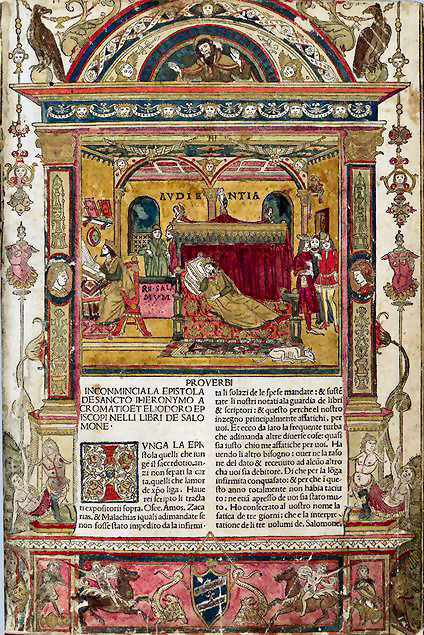
Latin Vulgate
The Latin Bible used before the Vulgate is usually
referred to as the Vetus Latina, or Old Latin Bible, or
occasionally the Old Latin Vulgate.
The Old Latin Vulgate
remained in use in some circles even after the Vulgate translation of
Jerome of Stridon
became the accepted standard throughout the Roman Catholic Church.
Gauls continued to prefer the Old Latin Vulgate for
centuries.
The Old Latin Vulgate was not translated by a single
individual or institution.
Not
uniformly edited each book varies in quality of translation and style.
The Old Latin Vulgate books were translated from Greek, not from
the Hebrew Septuagint as each book varies.
382 Emperor Theodosius I orders Jerome of Stridon
under the direction of Pope Damasus I and the Council of Rome to produce the
Latin Vulgate.
When Jerome of Stridon begins the translation of
the Vulgate into Latin he starts with the Septuagint.
The
Vulgate is written in everyday Latin, versio vulgata, as opposed to
Ciceronian Latin of which Jerome of Stridon was a master.
Roman Catholicism unites Western
Europe under the Pope for over a thousand years until
Martin Luther translates the Bible
into German.
The closest equivalent in English to the Latin
Vulgate is the King
James version which shows
a marked influence from
the Vulgate in the vigorous
rhythm of its prose and poetry.
The Vulgate, designed to be
easier to understand, was directly translated from Hebrew rather than the Greek
Septuagint.
Jerome of Stridon was responsible for at least three
slightly different versions of the Vulgate.
The Romana
Vulgate was the first, soon replaced by later versions except in Britain,
where it continued to be used until the Norman Conquest in 1066.
The
Gallicana Vulgate was produced a few years later with
revisions.
The Hispana Vulgate is largely identical to the
Romana Vulgate except for the book of Psalms, which Jerome of Stridon
translated from Hebrew.
Council of Rome makes it a capital offense to
practice any form of religion accept Nicene Christianity or
Judaism.
385 Pope Siricius leaves his wife in
order to become pope then decrees that
priests may no longer sleep with
their wives.
391
* TEMPLES RAZED *
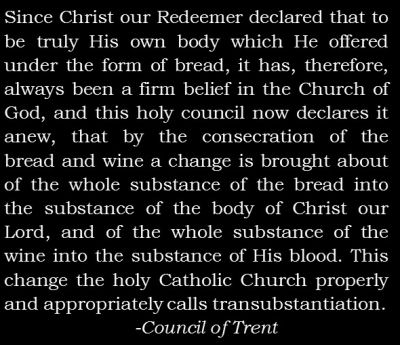 Church of Rome strives to refute the doctrines of Protestantism,
the Vulgate is reaffirmed in the Council of Trent as the sole
authorized text of the Bible.
Church of Rome strives to refute the doctrines of Protestantism,
the Vulgate is reaffirmed in the Council of Trent as the sole
authorized text of the Bible.
To reinforce this decree, an attempt is
made to standardize spelling and text of the Vulgate out of the
countless editions written during the Middle Ages.
1590 Pope Sixtus V (1585-90) produces the
Sistine Vulgate.
1592 Clement
VIII (1592-1605) produces the Clementine Vulgate which has been
the official Bible of the Roman Catholic
Church until the 1960s, when worship in vernacular languages
was first permitted.
Results are 7 Sacraments:
Catholicism is
the only religious truth
Pope holds the place of
Christ on Earth
Bread and wine is
physically transubstantiated
Sale of indulgences
ends
Dogma to be clearly defined
List of forbidden Protestant
translations
Mass to be in Latin using the Latin Vulgate
Forbidden: Simony, Nepotism,
Pluralism,
Absenteeism
Seminaries to
train priests 'properly' in the art of flogging
1907 Nova
Vulgata commissioned in by Pope Pius X of the Benedictine Monastery in
Rome, many decades pass before it is completed.
The main difference
between the Nova Vulgata and the Vulgata Clementina is that it
takes account of the modern textual criticism.
There are a number of
changes where the modern scholars felt that Jerome of Stridon had
failed to grasp the meaning of the
original languages.
Many modern scholars believe that the Greek
Hexapla is the main source for "iuxta Hebraeos"
by Jerome.
Jerome's translation of Exodus Iuxta
Hebraeos
"Starting from a careful textual comparison between
Jerome's translation of the Book of Exodus with the
Hebrew and the Greek translations, the dissertation delineates three ways
Jerome engages the Hebrew Bible.
He interprets the Hebrew by itself, he
may compare the Hebrew with the Greek versions, or he may rely on or respond to
an exegetical tradition.
Jerome's method of translation reflects the
influence of a Classical philological model.
Jerome seeks to render the
sense of the text rather than produce a slavishly literal translation.
Like the Classical commentators of his day, he initially concentrates
on the semantics and syntax of the text.
Only when the Hebrew is
unclear does Jerome consider the other translations and exegetical traditions.
The Vulgate interprets the Bible from a Classical, Christian, and
Jewish point of view and Jerome integrates these traditions through a
philological method.
Jerome's rendition must be understood as more than
a plain translation.
It should be read as a text that reflects the
intellectual currents of its day.
It must also be read as a Latin
interpretation of Scriptures.
The Vulgate must be treated as a work of
Latin scholarship and Latin literature." - Matthew Aaron Kraus
Spelling reflects a more Classical leaning than the
Renaissance spelling of the Clementine edition.
Nova
Vulgata does not contain some books found in some editions of the
Vulgate - for example the 3rd and 4th Book of Ezra.
The Nova
Vulgata is currently the official Latin version published and approved by
the Roman Catholic Church.
The Nova Vulgata has not been widely
embraced by conservative Catholics, as it sounds unfamiliar to the Clementine,
common in the history of the Bible as new translations attempt to supplant
older, more familiar ones.
The Stuttgart Vulgate is published by
the German BibleSociety (Deutsche Bibelgesellschaft), based in Stuttgart.
In this edition, Biblia Sacra Vulgata, the German BibleSociety
seeks to reproduce the original, pure Vulgate text that Jerome of
Stridon.
The Stuttgart Vulgate attempts, through critical
comparison of important, historical editions of the Vulgate, to achieve
the original text, cleansed of the errors of a millennium and a half's
time.
The critical source for the Stuttgart Vulgate is Codex
Amiatinus, an 8th century one-volume manuscript of the Latin Bible
produced in England, is regarded as the best medieval witness to original text
of Jerome of Stridon.
1952 Papyrus 1 and 655 are
found to be fragments of the Gospel of Thomas.
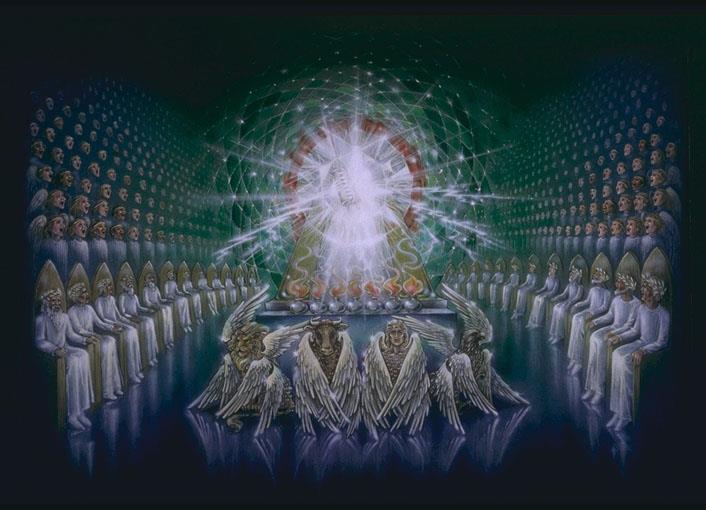
In conclusion, The Imperial State
Religion of Holy Roman
Catholic Church chose the books of New Testament that were to be the 'Word of God.'
Any writing that did
not fall within the dogma was systemically destroyed.
Much of
what Jesus actually said will remain a
mystery because the Holy Roman
Catholic Church chose the position as intercessor to
God.
The Holy Roman Catholic Church
defined the religion of
Christainity by defining the books that would be included in the Bible in
much the same way that the Church of Covid defined
itself.

"The highway will be called
The Way of Holiness;
it
will be for those who walk The Way.
The
unclean will not
journey on it."
Isaiah
35:8
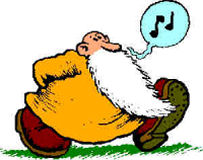
"People have
a neuro-psychological need
to believe their perceptions are correct, so they
reflexively discard or block out any
evidence that contradicts their narrative.
Shifting narrative
requires a psychological quantum leap that only comes in
a flash of insight." -
Paul Chefurka |
|

 |
This web site is not a commercial web site
and is presented for educational purposes only.

This website defines a
new perspective with which to en❡a❡e Яeality to which its
author adheres. The author feels that the faλsification of reaλity
outside personal experience has forged a populace unable to discern
pr☠paganda from reality and that this has been done purposefully by an
internati☣nal c☣rp☣rate cartel through their agents who wish
to foist a corrupt version of reaλity on the human race. Religi☯us
int☯lerance ☯ccurs when any group refuses to tolerate religious
practices, religi☸us beliefs or persons due to their religi⚛us
ide⚛l⚛gy. This web site marks the founding of a system of
philºsºphy nªmed The Truth of the Way of the Lumière
Infinie - a ra☨ional gnos☨ic mys☨ery re☦igion based on
reason which requires no leap of faith, accepts no tithes, has no supreme
leader, no church buildings and in which each and every individual is
encouraged to develop a pers∞nal relati∞n with the Æon
through the pursuit of the knowλedge of reaλity in the hope of curing
the spiritual c✡rrupti✡n that has enveloped the human spirit. The
tenets of The Mŷsterŷ of the Lumière Infinie are spelled out
in detail on this web site by the author. Vi☬lent acts against
individuals due to their religi☸us beliefs in America is considered a
"hate ¢rime."
This web site in no way c☬nd☬nes
vi☬lence. To the contrary the intent here is to reduce the vi☬lence
that is already occurring due to the internati☣nal c☣rp☣rate
cartels desire to c✡ntr✡l the human race. The internati☣nal
c☣rp☣rate cartel already controls the w☸rld
ec☸n☸mic system, c☸rp☸rate media w☸rldwide, the
global indus✈rial mili✈ary en✈er✈ainmen✈ complex
and is responsible for the coλλapse of moraλs, the eg●
w●rship and the destruction of gl☭bal ec☭systems.
Civilization is based on coöperation. Coöperation with
bi☣hazards of a gun.
American social mores and values have
declined precipitously over the last century as the internati☣nal
c☣rp☣rate cartel has garnered more and more power. This power rests
in the ability to deceive the p☠pulace in general through
c✡rp✡rate media by press☟ng em☠ti☠nal
butt☠ns which have been πreπrogrammed into the
πoπulation through prior mass media psych☣l☣gical
☣perati☣ns. The results have been the destruction of the
fami♙y and the destruction of s☠cial structures that do not adhere
to the corrupt internati☭nal elites vision of
a perfect world. Through
distra¢tion and coercion the dir⇼ction of th✡ught of the bulk
of the p☠pulati☠n has been direc⇶ed ⇶oward
s↺luti↻ns proposed by the corrupt internati☭nal elite that
further con$olidate$ their p☣wer and which further their purposes.
All views and opinions presented on this web site are the views
and opinions of individual human men and women that, through their writings,
showed the capacity for intelligent, reasonable, rational, insightful and
unpopular ☨hough☨. All factual information presented on this web
site is believed to be true and accurate and is presented as originally
presented in print media which may or may not have originally presented the
facts truthfully. Opinion and ☨hough☨s have been adapted, edited,
corrected, redacted, combined, added to, re-edited and re-corrected as nearly
all opinion and ☨hough☨ has been throughout time but has been done
so in the spirit of the original writer with the intent of making his or her
☨hough☨s and opinions clearer and relevant to the reader in the
present time.
Fair Use Notice
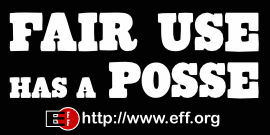
This site may contain
copyrighted material the use of which has not always been specifically
authorized by the copyright owner. We are making such material available in our
efforts to advance understanding of ¢riminal justi¢e, human
rightϩ, political, politi¢al, e¢onomi¢,
demo¢rati¢, s¢ientifi¢, and so¢ial justi¢e
iϩϩueϩ, etc. We believe this constitutes a 'fair use' of any
such copyrighted material as provided for in section 107 of the US Copyright
Law. In accordance with Title 17 U.S.C. Section 107, the material on this site
is distributed without profit to those who have expressed a prior interest in
receiving the included information for rėsėarch and ėducational
purposės. For more information see:
www.law.cornell.edu/uscode/17/107.shtml. If you wish to use copyrighted
material from this site for purposes of your own that go beyond 'fair use', you
must obtain permission from the copyright owner. |
 Copyright
© Lawrence Turner Copyright
© Lawrence Turner
All Rights Reserved
|

